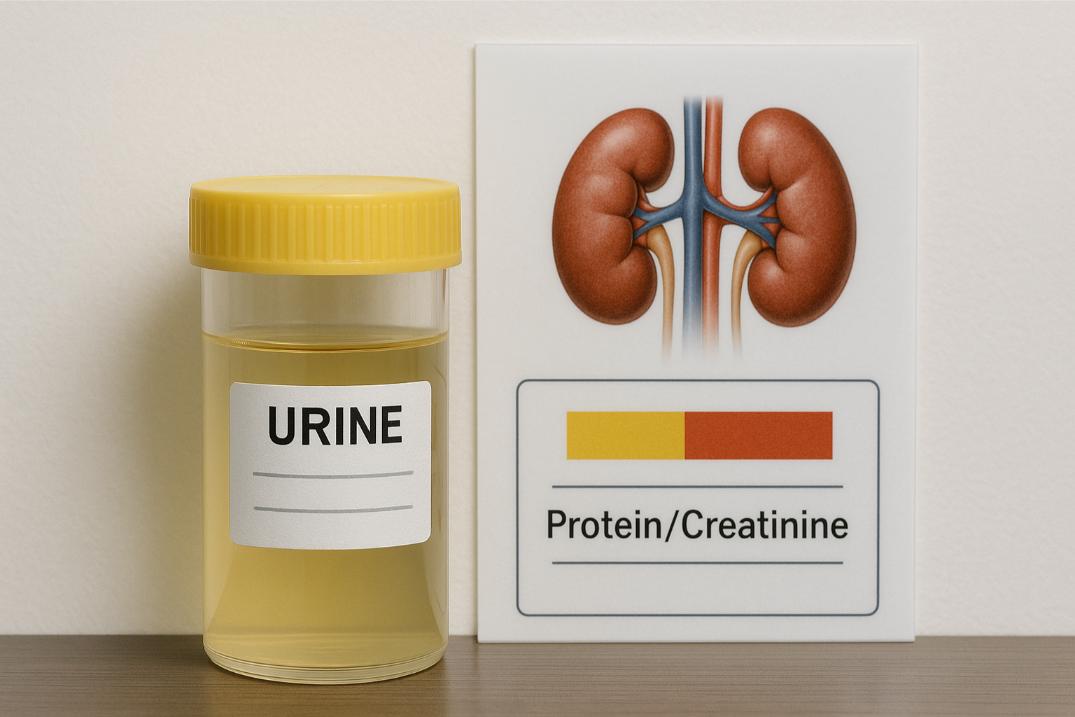What is the Normal Urine Protein/Creatinine Ratio? Its Importance in Kidney Health
 Written By
Jaclyn P. Leyson-Azuela, RMT, MD, MPH
Written By
Jaclyn P. Leyson-Azuela, RMT, MD, MPH

If you are concerned about your kidney’s health, you may have asked what is the normal urine protein/creatinine ratio (UPCR). The UPCR is an important measurement that helps doctors assess your kidney’s function. It is able to detect problems early. It is a simple test that provides valuable insights about the status of your kidney. When proteins leak into urine at higher than the usual levels, it often signifies that there is something wrong with your kidneys. It could be a sign of damage that requires medical attention.
Key Takeaways
-
Normal urine protein/creatinine ratio is less than 150 mg/g for adults and children more than 2 years old
-
Infants 6-24 months old normally have values below 500 mg/g
-
During pregnancy, values of 300 mg/g or higher may be a sign of preeclampsia
-
The test requires a sample random urine instead of a 24-hour urine collection
-
Persistently high normal results warrants further investigation for kidney problems
What does a Urine Protein/Creatinine Ratio Mean?
The UPCR is a simple lab test that helps doctors check whether you have kidney problems. It checks how much protein there is in your urine compared to creatinine. Your kidneys should not allow proteins to pass to the urine. So it has to return them to the blood and keep it there. But if proteins are found in the urine, it could mean that your kidneys are not working well.
What Does The Test Measure?

The test measures the total amount of protein that your urine has compared to creatinine. The latter is a waste product that your body makes at a constant and steady rate. By comparing the levels of protein to creatinine, doctors can tell if you have too much protein in your urine. And that is even if the urine is diluted (overhydrated) or very concentrated (dehydrated).
If you measure protein on its own, it may seem abnormally high because the urine is concentrated. Protein may also appear low if the urine is diluted. Using the ratio equation between the two fixes this dilemma.
How is the Ratio Calculated?

The ratio is determined using a simple mathematical formula. Labs take the protein concentration in mg/dL and divide this by the creatinine concentration in mg/dL. The resulting unit is mg/g.
*NOTE: The unit varies with each laboratory facility you go to. Some labs express this as mg/mg or mg/mmol. It is usually reported as a number without the unit.
For instance, if your urine protein is 15 mg/dL and your creatinine is 100 mg/dL, your ratio would be 15÷100 = 0.15, which is reported as 150 mg/g.
Why is The Urine Protein/Creatinine Ratio Measured?
The purpose of this test is to allow doctors to assess kidney function. It detects some form of problems even at its early stages. Proteins are not expected to appear in your urine especially in large amounts. So when it is present in high levels, it may mean that there is something wrong with your kidneys.
What Conditions Can it Help Diagnose?
The UPCR test can help diagnose several kidney conditions, such as:
-
Chronic kidney disease (CKD)
-
Glomerulonephritis (inflammation of the kidney filters)
-
Diabetic nephropathy (kidney damage from diabetes)
-
Lupus nephritis (kidney inflammation from lupus)
-
High blood pressure damage to kidneys
When proteins are detected in your urine, doctors can find clues as to what is happening to your kidneys and find out what causes its decline in function.
How is it Used in Monitoring Kidney Health?

The lab test is not only requested to look for kidney problems. But it can also be used to keep track of your kidney’s health over time. Below are some of the ways that the lab test can be used:
-
See if your kidney problem is getting better or progressing
-
Check if the treatments are working
-
Make sure that your kidneys are in healthy condition particularly if you have high blood pressure or diabetes
The lab test is like a tracker specific for your kidneys. It gives you and your doctor regular updates on how well your kidneys are doing during the test.
What is the Normal Range for Urine Protein/Creatinine Ratio?
The normal range for UPCR changes by age group and status like whether pregnant. So depending on what age group you belong to, the amount changes.
Normal Range for Adults
The normal result of UPCR for adults is less than 150 mg/g. If the result that you got is higher than this value, it does not automatically mean you have a kidney problem. But your doctor will want to investigate more.
Also, laboratories use their own specific ranges so this value could also vary accordingly. So you need to look at what your lab is using for their normal values.
Normal Range for Children
For kids older than 2 years old, the normal range is basically the same as that of adults at less than 150 mg/g.
For babies, on the other hand, between the age of 6 and 24 months old, the normal range is higher at 500 mg/g. The reason for this high normal value is because their kidneys are still growing and developing. So you don’t need to worry about it at all.
Normal Range During Pregnancy
During pregnancy, a woman’s body undergoes a lot of changes. The UPCR may have a slight increase, which is perfectly normal at times. However, if the UPCR reaches about 300 mg/g or higher, it may be a sign of pre-eclampsia, which means immediate medical attention is warranted because it is a serious condition.
This is particularly worrisome if you are diagnosed with a case of high blood pressure. An increase in UPCR values together with a high blood pressure spells trouble during pregnancy.
How the Urine Protein/Creatinine Ratio Test Performed?
The UPCR test is easy and does not bring about any discomfort at all. You don’t need to collect 24-hour urine, which historically was a 24-hour urine collection.
What Sample is Needed?
You only need to give a single urine sample, which you need to submit in a cup. You will submit it to the laboratory, where the technologists will process the sample. You can get the results later as per advice of the laboratory releasing officer.
The whole process is a lot easier than getting a 24-hour urine sample.
Are There Any Preparations Required?
For most people, no special preparation is needed for the test. There is no need to fast or to stop taking your medications.
Sometimes your doctor gives you specific instructions, like avoiding strenuous physical activity before the test as this could affect the result. Always follow your doctor’s advice for accurate results.
What Do Abnormal Urine Protein/Creatinine Ratio Results Mean?

Getting the test results can be scary especially if it shows abnormal values or they’re not within the expected range. That is understandable, which is why you need to understand what your results could mean in the following sections.
What Does a High Ratio Indicate?
A high UPCR, which is generally defined as having a result of more than 200 mg/g for adults, suggests that your body is losing proteins via urine. When proteins leak to your urine, this is a condition called proteinuria. And, it can happen because your kidney is damaged. Conditions that can damage your kidneys include:
-
Diabetes
-
High blood pressure
-
Inflammation of the kidneys
-
Side effect of some medicines
-
Infections
-
Heart failure
Protein doesn’t leak in the urine in high amounts. There is an acceptable level that they can leak out of the kidneys. But, when they occur in high amounts (especially if you did not have any strenuous activity prior to the testing), it usually means trouble and immediate fixing must be done.
What Does a Low Ratio Indicate?
Having a low UPCR result is usually not a problem. In fact, the lower the ratio is, the better. Having a zero value on your results could mean that the test was an error and it had to be retested.
When Should You Be Concerned About Your Result?
Just having one high result doesn’t always cause an alarm. Your doctor may request a repeat test.
However, you should be worried if:
-
The UPCR ratio stays high even with repeated tests
-
The ratio is progressively increasing over time
-
You start to manifest other symptoms of kidney disease
-
You have diabetes or high blood pressure along with a high UPCR ratio
Be careful when interpreting your own laboratory results or search about it on your own. You should always talk to your doctor when something is worrying you. They can accurately interpret your results and discuss things about your health.
How Does the Urine Protein/Creatinine Ratio Compare to Other Kidney Tests?
UPCR test is the only test that will measure the amount of protein in your urine. But how does it compare to other kidney tests?
Comparison with 24-Hour Urine Protein Test
The 24-hour urine test is the gold standard for detecting protein. In this test, you have to collect all your urine for a full day. While it is very accurate for albumin, it was too inconvenient.
The UPCR is a much more convenient and nearly as reliable method of detecting urine protein. With less effort, you can get the amount of protein in your urine.
Comparison With Urine Albumin/Creatinine Ratio
The urine albumin/creatinine ratio (uACR) is specific for albumin measurement. It is specific for albumin alone while UPCR measures all proteins.
The uACR is better for detecting very early kidney disease particularly in people who have diabetes. It can detect even a small amount of albumin, which is called microalbuminuria that may not show up on UPCR.
When to Use Which Test?
Your doctor may request different diagnostic tests that are based on your specific situation or condition.
-
UPCR: Used for general screening and monitoring of most kidney diseases but not specific or no kidney disease to narrow down in particular
-
24-Hour Urine: May be useful when confirming results particularly in special cases.
-
uACR: Excellent for people who have underlying medical conditions like diabetes or to check for very early stages of kidney damage
Each of these tests are different tools that have its own special use.
Conclusion
The urine protein/creatinine ratio is an essential test to determine kidney health and function. It gives doctors a snapshot or an overview of how well your kidneys are working. If your doctor catches protein leaks early, you will be able to discuss the steps to take in order to protect your kidneys before any real damage happens. Remember, healthy kidneys keep proteins where they belong and will not allow leaking. If protein is leaking out, discuss with your doctor what may be causing it and take necessary action to fix the problem.
If you are concerned about your kidney’s health, test your urine using Ribbon Checkup today!

Written by Jaclyn P. Leyson-Azuela, RMT, MD, MPH
Jaclyn P. Leyson-Azuela, RMT, MD, MPH, is a licensed General Practitioner and Public Health Expert. She currently serves as a physician in private practice, combining clinical care with her passion for preventive health and community wellness.
References
-
Haider, M. Z., & Aslam, A. (2023, September 4). Proteinuria. PubMed; StatPearls Publishing. https://www.ncbi.nlm.nih.gov/books/NBK564390/Olayinka, L., Garnett, E., Burnett, B., & Sridevi Devaraj. (2023). Comparison of random urine protein/creatinine ratio with 24-hour urine protein in suspected pre-eclampsia. Practical Laboratory Medicine, 36, e00316–e00316. https://doi.org/10.1016/j.plabm.2023.e00316
-
Kamińska, J., Dymicka-Piekarska, V., Tomaszewska, J., Matowicka-Karna, J., & Koper-Lenkiewicz, O. M. (2020). Diagnostic utility of protein to creatinine ratio (P/C ratio) in spot urine sample within routine clinical practice. Critical Reviews in Clinical Laboratory Sciences, 57(5), 345–364. https://doi.org/10.1080/10408363.2020.1723487
-
KDIGO. (2013). Official Journal of the International Society of Nephrology KDIGO 2012 Clinical Practice Guideline for the Evaluation and Management of Chronic Kidney Disease. https://kdigo.org/wp-content/uploads/2017/02/KDIGO_2012_CKD_GL.pdf
-
Liu, T., Xue, B., Du, B., Cui, T., Gao, X., Wang, Y., Wang, B., & Wei, J. (2021). Reference values of urine protein/creatinine ratio in healthy Dalian adults. Journal of Clinical Laboratory Analysis, 35(11). https://doi.org/10.1002/jcla.24043

Jaclyn P. Leyson-Azuela, RMT, MD, MPH, is a licensed General Practitioner and Public Health Expert. She currently serves as a physician in private practice, combining clinical care with her passion for preventive health and community wellness.



